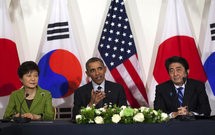 Since late 2011, the Obama administration has been repeatedly trumpeting a new strategy to sustain and strengthen the US’s interests in the Asia-Pacific.
Since late 2011, the Obama administration has been repeatedly trumpeting a new strategy to sustain and strengthen the US’s interests in the Asia-Pacific.
First, then Secretary of State Hillary Clinton published an article highlighting the need for Washington to “pivot to Asia” and then the President himself said so while addressing the Australian parliamentarians.
In the face of China’s ferocious warning against any new containment strategy to prevent its rise, the Obama administration promptly rechristened the strategy as “rebalancing” that would engage China, strengthen allies and befriend new strategic partners. The rebalancing, moreover, would consist of military, economic and political dimensions. The US push for a Trans-Pacific Partnership Agreement was touted as the economic leg of rebalancing.
But traditional allies of the US in Europe and West Asia too were critical and suspicious of this new strategy. The Europeans thought it would dent the Trans-Atlantic alliance and the West Asians felt that the US would abandon them after the end of the Iraq War, planned withdrawal from Afghanistan, and the discovery of shale gas reserves the country.
Significantly, the Asian allies of the US drew little comfort from the rebalancing strategy. Most of them today find in China an attractive economic partner and the US economic attractiveness has lost the competitive edge. When the Bush and the Obama administrations got preoccupied with tackling other problems since 2001, the Asian allies started feeling neglected.
However, when Washington woke up to the new reality of the expanding Chinese hegemony in the Asia-Pacific and strategised to set a new balance that would not corrode its traditional influence in the region, the ‘pivot to Asia‘ or ‘Asia rebalancing’ doctrine saw the light of the day.
But to the US’ dismay and its allies’ distress, China buried its concept of ’peaceful rise’ and began to use measured force to retaliate against the US’ strategy. Beijing’s naval assertiveness in the East and South China Seas should be examined in the light of its anger against the new Obama doctrine.
Tension along the Sino-Indian border; the Senkaku/Diaoyu Islands dispute; the Scarborough Shoal issue; Beijing’s declaration of an Air Defense Identification Zone; the reassertion of Chinese claim of sovereignty over almost whole of the South China Sea; and the Sino-Vietnamese spat over maritime boundaries are among the many developments have resulted in cold confrontation between China and the US.
The aforementioned examples indicate a clear pattern of Chinese leadership picking up issues with either traditional US allies, such as Japan and the Philippines, or new strategic partners like India and Vietnam. Cold confrontation between the reigning superpower and the challenger is not confined to these events alone. China has built a robust navy with an anti-access and area-denial capability, and the US has instated new Air-Sea battle capability.
The fundamental challenge to this emerging security scenario lies in the fact that both the US and its allies and strategic partners have substantive economic relations with China. Accordingly, the US appears less confident on the prospects of its allies standing by their expected commitments in its differences with China, and vice versa.
When President Obama failed to attend the Asia-Pacific Economic Cooperation and the East Asia Summits in October 2013 due to domestic political constraints, Washington’s ability to implement the rebalancing strategy came to be questioned in Asia. Obama’s failure to stand up to his promise when Syrian President crossed the so-called “Red Line” and the US’ perceived feeble response to developments in Ukraine further raised doubts about Washington’s willingness to sternly deal with an assertive China.
Asian allies began to feel that, despite statements and proclamations, Washington’s attention has been confined to developments in Europe and West Asia. In order to reassert the US influence in the Asia-Pacific, recently, Obama spent eight days visiting four Asian countries.
In Tokyo, the US president made it clear that he would invoke the alliance treaty with Japan in an event of Sino-Japanese armed conflict over island disputes. In Seoul, he assured the South Koreans that the US would “protect” the country from any North Korean invasion. In Manila, Obama succeeded in inking an agreement that would make Filipino military facilities accessible to the US forces and military machines. In Kuala Lumpur, Obama became the first US President to set foot in Malaysia in five decades, and his charm worked to some extent.
However, the expected US-Japan positive statement on TPP did not materialise; and the US military commitment can be tested only when there is a contingency. Just days after Obama returned to the US, China promptly sent a message by placing oil rigs near Paracel Islands and ramming Vietnamese ships. Clearly, the US rebalancing will keep encountering cold confrontation with China in years to come.
By Special Arrangement with Institute of Peace and Conflict Studies (http://www.ipcs.org)